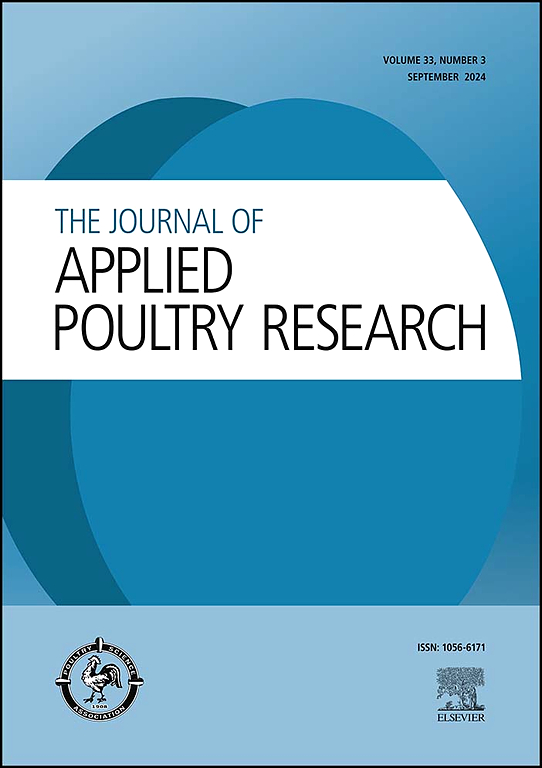鸡混合灭活疫苗联合免疫免疫效果的可行性分析与研究
IF 2
3区 农林科学
Q2 AGRICULTURE, DAIRY & ANIMAL SCIENCE
引用次数: 0
摘要
联合免疫有几个好处,如减少疫苗接种频率,最大限度地减少应激反应,降低劳动力成本。本研究旨在制定一种使用混合疫苗的联合免疫策略,并分析将灭活疫苗纳入该方案的可行性。此外,该研究验证了多种灭活疫苗混合联合免疫的实际效果。本研究由三个部分组成。最初,将ND-AI H9二价灭活疫苗和AI H5/H7三价灭活疫苗混合。分析了所得到的悬浮液的物理化学性质,包括粒径、稳定性和内毒素水平,以评估混合疫苗的可行性。将混合疫苗接种于SPF鸡,测定抗体效价,初步评价联合接种方法的免疫效果。最后,在一个大型蛋鸡养殖场实施联合免疫策略,并监测抗体滴度以评估其在生产环境中的免疫效果。禽流感H9疫苗与禽流感H5/H7疫苗混合后,悬浮液的粒径介于两种原疫苗之间,其分布规律与单一疫苗相似。储存7天后,悬浮液没有分离,没有微生物污染,内毒素水平很低。SPF鸡经混合疫苗免疫后,抗ND和AI的抗体滴度与单疫苗免疫相比无显著差异。在某大型蛋鸡养殖场应用混合疫苗联合免疫方案后,目标疾病的中和抗体水平达到预期,阳性率高,变异系数低。结果表明,禽类混合灭活疫苗联合免疫是可行的、容易实施的、有效的。它减少了注入频率和压力,节约了资源,为广泛应用提供了一种快速有效的方法。这一策略对多价灭活疫苗的开发也具有重要意义。值得注意的是,本研究中使用的所有疫苗均为灭活油乳剂家禽疫苗,疫苗的施用按照农场特异性免疫计划进行,并通过联合免疫方案在兽医的直接监督下进行。本文章由计算机程序翻译,如有差异,请以英文原文为准。
Feasibility analysis and study on immune effects of combined immunization with mixed inactivated vaccines in chickens
Combination immunization offers several benefits, such as reducing vaccination frequency, minimizing stress responses, and lowering labor costs. This study aimed to develop a combined immunization strategy using mixed vaccines, and to analyze the feasibility of incorporating inactivated vaccines into this regimen. Furthermore, the study validated the practical effects of combination immunization with a mixture of multiple inactivated vaccines. The study is composed of three parts. Initially, the ND-AI H9 bivalent inactivated vaccine and the AI H5/H7 trivalent inactivated vaccine were mixed. The physicochemical properties of the resulting suspension, including particle size, stability, and endotoxin levels, were analyzed to assess the feasibility of the mixed vaccine. Then the mixed vaccine was administered to SPF chickens, and antibody titers were measured to preliminarily evaluate the immunization efficacy of the combined vaccination approach. Finally, the combined immunization strategy was implemented in a large-scale layer farm, with antibody titers being monitored to assess its immunization effectiveness in a production setting. After mixing the ND-AI H9 vaccine with the AI H5/H7 vaccine, the particle size of the suspension fell between the two original vaccines, with the similar distribution pattern as the single vaccines. After seven days of storage, the suspension showed no separation, no microbial contamination, and very low endotoxin levels. When SPF chickens were immunized with the mixed vaccine, the antibody titers against ND and AI had no significant difference compared to that of single vaccine immunization. Following the application of the combined immunization program using the mixed vaccine in a large-scale layer farm, the neutralizing antibody levels for the targeted disease met expectations, with high positivity rates and low coefficients of variation. These results demonstrate that the combined immunization, employing mixed inactivated vaccines for poultry, is feasible, easy-to-implement and effective. It reduces injection frequency and stress, conserves resources, and offers a rapidly efficient method for widespread application. This strategy also holds significant implications for the development of multivalent inactivated vaccines. It should be noted that all vaccines utilized in the present study were inactivated oil-emulsion poultry vaccines, the administration of which was executed in accordance with the farm-specific immunization schedule and under the direct supervision of the veterinarian through a combined immunization protocol.
求助全文
通过发布文献求助,成功后即可免费获取论文全文。
去求助
来源期刊

Journal of Applied Poultry Research
农林科学-奶制品与动物科学
CiteScore
4.10
自引率
10.50%
发文量
80
审稿时长
104 days
期刊介绍:
The Journal of Applied Poultry Research (JAPR) publishes original research reports, field reports, and reviews on breeding, hatching, health and disease, layer management, meat bird processing and products, meat bird management, microbiology, food safety, nutrition, environment, sanitation, welfare, and economics. As of January 2020, JAPR will become an Open Access journal with no subscription charges, meaning authors who publish here can make their research immediately, permanently, and freely accessible worldwide while retaining copyright to their work. Papers submitted for publication after October 1, 2019 will be published as Open Access papers.
The readers of JAPR are in education, extension, industry, and government, including research, teaching, administration, veterinary medicine, management, production, quality assurance, product development, and technical services. Nutritionists, breeder flock supervisors, production managers, microbiologists, laboratory personnel, food safety and sanitation managers, poultry processing managers, feed manufacturers, and egg producers use JAPR to keep up with current applied poultry research.
 求助内容:
求助内容: 应助结果提醒方式:
应助结果提醒方式:


